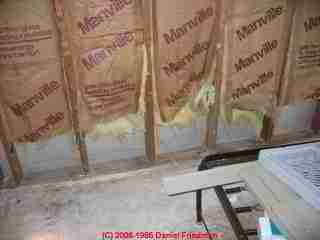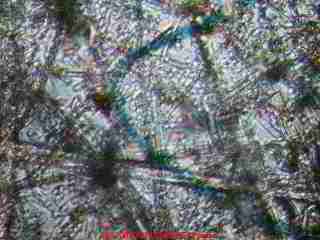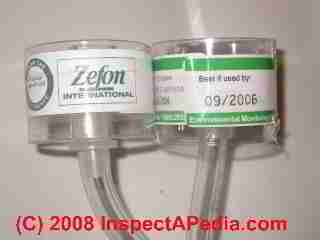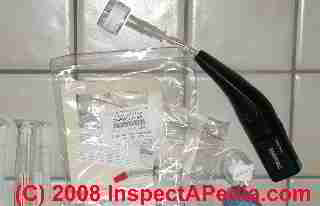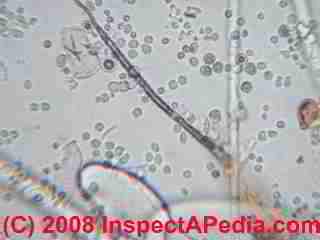 Step by Step Test For Mold Contamination in Fiberglass & Similar Building Insulation Products
Step by Step Test For Mold Contamination in Fiberglass & Similar Building Insulation Products
- POST a QUESTION or COMMENT about how to test for mold contamination in building insulation
Insulation mold test procedure:
This document describes step by step field test procedures to screen for the presence of mold contamination in fiberglass insulation in residential and light-commercial buildings.
This article series explains how to find or test for moldy insulation in buildings, the probable cause of mold contamination in building insulation, and how to recognize conditions that make that problem likely in a particular case.
InspectAPedia tolerates no conflicts of interest. We have no relationship with advertisers, products, or services discussed at this website.
- Daniel Friedman, Publisher/Editor/Author - See WHO ARE WE?
Guide to Testing for Mold in Building Insulation
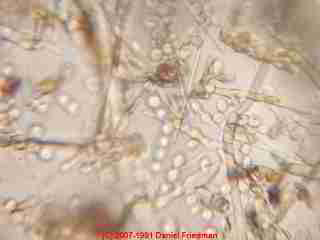
This article series discusses health hazards associated with moldy fiberglass in buildings, with focus on fiberglass insulation, fiberglass fragments, fiberglass in heating and air conditioning duct work, and invisible but toxic mold growth in fiberglass which has been wet, exposed to high humidity, or exposed to other moldy conditions.
The photo at left, another sample we collected the interior of mold-suspect insulation shows extensive chains of Penicillium/Aspergillus type mold spores, suggesting that this fungus is probably growing in the insulation itself.
Fiberglass in building insulation is a topic I have been testing and studying since 1986, after having traced building mold concerns to a hidden source in this material.
We frequently find high levels of mold-contaminated fiberglass insulation in buildings which contain other large mold reservoirs.
We have also detected high levels of problematic mold in fiberglass building insulation where other mold reservoirs were either not present or had been previously removed.
Actual Mold Growth in Insulation - Fiberglass insulation can host active mold growth
The presence of both mold spore chains and conidiophores of Aspergillus sp. in the insulation test samples whose photos are shown above confirmed that not only was the crawl space ceiling fiberglass insulation moldy, but it was supporting active fungal growth.
Our screening samples confirmed that this mold was present in other building areas, most-likely emanating from this mold reservoir of mold-contaminated fiberglass insulation.
In some of cases, non-visible mold contamination in fiberglass insulation has been enough to cause IAQ, health, or other mold-related complaints by building occupants, and in some cases
In the partially-opened basement wall shown here at left, the water track stains on the cavity side of the exposed drywall (shown after a test cut was made) indicate that water passed in this wall from above.
In this circumstance, even when the fiberglass insulation looks clean, I often find high levels of Penicillium sp. or Aspergillus sp. in this material. Comparison tests of fiberglass which is new at a building supply store or in homes where the insulation has not been wet nor infested with rodents or other pests, mold is rarely a problem.
The photo at above right shows a very dense presence of Pen/Asp spores and spore chains in this insulation test sample.
Where to Look for Mold in Building Insulation
For buildings which do not have other known mold reservoirs, special attention needs to be given to inspecting and testing for problematic mold in
- Wet building insulation: Fiberglass insulation in any building cavity which has been wet - wet once in the past, wet regularly, even if no longer wet.
- Insulation exposed to moisture: Fiberglass insulation over wet or damp basements
- Insulation in suspect areas: Fiberglass insulation over crawl spaces; fiberglass insulation in areas forming a moisture trap such as insulation between a metal roof and a poly vapor barrier (that is probably imperfect and penetrated, or exposed to leaks)
- Insulation in suspect areas: Fiberglass insulation in attics or roof cavities where there has been leakage
- Insulation exposed to airborne contaminants: such as mold that was growing on other building surfaces such as drywall, paneling, or cardboard boxes, or insulation that was not protected from or removed from mold remediation or cleanup project areas
- Insulation exposed to leaks: Fiberglass insulation in building walls subject to leaks from plumbing failures,previous wetting due to building fire extinguishment, or in freezing climates, walls subject to leaks from ice damming.
- Insulation inside or on the exterior of air ducts and HVAC equipment air handlers: Fiberglass heating or cooling duct material, especially if it has been wet from building leaks or A/C condensate mishandling
How to Test Building Insulation for Mold Contamination
We provide the following procedure for testing building insulation for mold for two purposes.
- To invite feedback and procedural improvements from other field investigators and building professionals
- To provide a simple, inexpensive mold sampling procedure that building owners or occupants of limited financial means can use to get an idea about possible mold contamination in building insulation - a problem area which is often missed by building and mold inspectors.
See INSULATION MOLD CONTAMINATION TEST for more detailed discussion about the occurrence of mold in building insulation.
Visually Inspect Insulation For Mold & Leaks First

Before testing apparently "clean" building insulation for mold contamination, look at all of the accessible insulation areas for evidence of visible mold or evidence of leak or water damage that may have wet the insulation.
Adhesive Tape Samples of Settled Dust or Suspected or Visible Mold on Building Surfaces such as Insulation Backing or Kraft Paper, Walls, Wood Framing
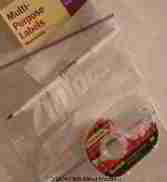 Most of this article discusses using methods such as vacuuming or perhaps bulk sampling to sample or test fiberglass insulation for non-visible contamination. But what about sampling visible dust, debris, or mold?
Most of this article discusses using methods such as vacuuming or perhaps bulk sampling to sample or test fiberglass insulation for non-visible contamination. But what about sampling visible dust, debris, or mold?
If you see moldy kraft paper backing on building insulation it's reasonable to assume that the insulation is contaminated and that it should be removed, the cavities cleaned, and the cause of mold corrected.
Further mold tests may not be necessary unless needed for medical reasons or for the purpose of comparison with building mold detected in other samples from other areas before or after a building mold cleanup project.
An inexpensive and easy method for collecting settled building dust for screening or for collecting suspected mold or other problem particles from building surfaces requires clear adhesive tape, a clean freezer-type plastic bag, and an examination to choose sampling points that you think are representative of building conditions.
See TAPE & BULK SAMPLING & TESTS for MOLD for details of how to use adhesive tape for surface sampling of dust, particles, or suspected mold growth on building surfaces.
And see FIBERGLASS AIR DUCT MOLD TEST for an example of using adhesive tape to identify mold growth on the interior of HVAC air ducts.
How to Collect Bulk Samples of Insulation to be Tested for Problem Mold Contamination
For people who cannot obtain field services to inspect and vacuum-test building insulation for problem mold, it is possible to cut and remove a square foot of mold-suspect insulation to be sent as a bulk sample to a forensic lab for testing. What we don't like about this approach is that the cost and trouble generally mean that only one or two samples will be collected, reducing our confidence in the conclusion. That is, a lot depends on exactly where and when a mold test sample is collected, and it's a bit too easy to collect a "clean" sample that misses a problem in the building.
If you must collect one or two bulk samples of fiberglass insulation to be tested for mold, we suggest
- Collect the sample from the most-suspect area(s) of the insulation, such as areas that are known to have been wet or known to have been exposed to problem locations in a building.
- Collect a square foot of insulation, cutting carefully and neatly through the entire insulating blanket, to include the full thickness of the insulation material as well as any plastic, foil, or kraft paper backing on the insulation.
- Package the insulation sample in a clean Zip-Lok type plastic bag. It's ok if the insulation is compressed for shipping.
The lab will construct a sterile chamber in which each insulation sample will be agitated and then debris from the insulation will be collected for qualitative analysis.
How to Collect Vacuum Dust Samples of Mold-Suspect Insulation
This procedure prepares dust samples from building insulation for qualitative analysis in a mold lab. (Quantitative analysis by this method would be inaccurate, but it's also unnecessary.)
While some mold inspectors use more sophisticated equipment, the presence or absence of significant problem mold contamination in fiberglass (or other porous) insulation materials, as well as the presence or absence of high levels of other problem particles such as insect allergens, insect fragments (cockroach parts), or even bird dropping contamination can be detected by a competent forensic laboratory from even an amateur-collected insulation sample collected by the process we describe here.
Equipment you'll need to Vacuum-Sample Fiberglass Insulation for Mold
- Appropriate protective clothing, gloves, eye cover, respirator, etc. for entering dusty areas.
- Air sampling cassettes such as those provided by Zefon Corp. (Air-o-Cel™) or Allergenco™
We have done a long term comparison study comparing these brands, and both work just fine.
- A vacuum pumping device that operates in the recommended air-flow range of 10 lpm.
An inexpensive pump that we have tested is the common keyboard vacuum pump sold by Radio Shack™.
While there is some variation in the pump rate of these devices, we found that the pump rate was not excessive (which causes particle bounce and loss in the collection cassette) nor too weak (which fails to collect and adhere particles in the device), and was usable for rough presence-or-absence testing of mold contamination in insulation.
If you already have or can borrow or rent a more sophisticated air sampling pump such as our Burkard Personal Air Sampler [photo] or another type calibrated air sampling pump that uses a prepared microscope slide to collect dust particles, and that can be set to the flow rate required by the air sampling cassette, that's great, but it's not necessary for rough presence-or-absence qualitative analysis of building insulation mold. But your pump needs to be portable.
Extension cords etc. are not so convenient and can even be unsafe when crawling around in tight crawl spaces or tiny attic kneewall areas. - A plastic tube section about 4" long that will fit into the suction end of the vacuum pump, and onto which an air sampling cassette can be easily attached. (Just take your pump and cassette to a nearby hardware store selling short lengths of clear clean plastic tubing.)
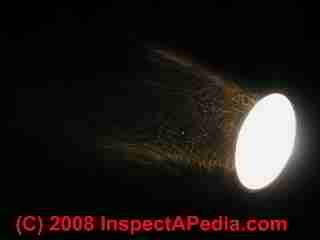
- A flashlight to roughly assess the airborne dust level during sampling. Our photos above show a high level of airborne dust in a dark attic in the photo at left, and in the right-hand photo an excessive, overloading level of dust in the same location when we over-agitated the insulation. The amount at left is more than enough debris for a short sample collection interval of a few seconds. Don't overload a dust sample in an air-sampling cassette or it's hard for the lab to make sense of its contents.
- Appropriate sample control sheets and paper for writing notes about when, where, how the samples were obtained.
- Clean plastic bags or other packaging to mail your samples. Call your mold test lab ahead of time to agree on the price and to discuss the form and type of samples you're sending and the level of analysis you want.
Accuracy of Insulation Vacuum Samples for Mold Testing
This mold sample insulation vacuum approach is not suitable for quantitative analysis such as determining the number of mold spores per cubic foot of material.
But then, our tests have demonstrated that there is already an enormous variation in the absolute level of mold spores pulled from building insulation depending many variables:
- The insulation condition, new, old, wet, dry, fiber density
- The type of insulation: chopped vs blanket
- The extent to which insulation has been covered by other materials or left exposed to water or air
- the level of actual contamination,
- the mold genera (some species are more easily airborne than others),
- the vacuum rate of the pump,
- how close the pump is held to the insulation source,
- the degree of agitation of the insulation, ranging from "didn't touch it" to "agitated it with a pencil before vacuuming" to "stomped all over it"
But this approach will easily tell you what sort of particles and at what density they are found in an insulation sample, and it's easily the most inexpensive method available for testing building insulation.
How to Collect Dust Particle Samples from Building Insulation
Here is a summary of a reasonable tape sampling procedure.
- Select the insulation area to be tested
- Prepare your vacuum pump, tube, and mounted cassette so that it's ready to use, but leave it turned off.
- Using a screwdriver or pencil, make an opening in the center of the test area that penetrates between 1/2 and 7/8 of the thickness of the insulation.
- Using the same probing device as in step 2, agitate the insulation from side to side for 3-10 seconds.
- Hold the collection cassette facing the insulation and 1/2" to 6" away from the insulation. If you see that your agitation of the insulation has stirred a visible cloud of dust use the longer distance.
- Turn on the vacuum pump for 2-10 seconds, then turn it off.
- Check the sample: Remove the air sampling cassette and look into the collection slot in a good light. If the collection slot is loaded with insulation fibers and debris the sample is overloaded and you should try again using a shorter vacuum-on interval and a larger distance from the insulation; don't collect the sample more than 12" from the insulation nor without agitating the insulation at all or you risk sampling airborne particles from another source.
- Seal the sample collection end and vacuum end with the adhesive tabs provided so that other debris won't enter the device.
- Mail your insulation sample along with the control sheet to a mold test lab or forensic lab of your choice.
What the Mold or Forensic Lab Should Report from an Insulation Mold Sample
The forensic particle identification (or mold test) lab will need to determine the dominant particles in dust collected from the insulation samples and to compare those results with these base points:
- New clean fiberglass insulation
- Old fiberglass insulation in buildings and common particles found there
- High frequency or dominant-particle presence of problematic mold spores, fungal material, or other contaminants. Our photo at left shows a high level of Aspergillus sp. mold spores and our photo near the top of this page shows mold spore chains confirming actual mold growth in mold-contaminated building insulation.
By examining the density of mold obtained from an insulation sample and also by examining the mold qualitatively (such as for the presence of spore chains of Penicillium sp. or Aspergillus sp., a lab should be able to tell you if the insulation is
- Generally clean insulation consistent with new material
- Mold contaminated by dust and debris exposure
- Contaminated with high levels of insect fragments or other possible respiratory irritants
- Mold-contaminated with evidence of mold growth or colonization within the insulation.
...
Continue reading at VACUUM TEST INSULATION CONTAMINANTS or select a topic from the closely-related articles below, or see the complete ARTICLE INDEX.
Or see these
Recommended Articles
- BLOWER LEAKS, RUST & MOLD for Readers concerned with mold contamination in heating and air conditioning air handlers and ductwork
- FIBERGLASS AIR DUCT MOLD TEST - using tape to test & identify debris on HVAC duct interior surfaces
- FIBERGLASS INSULATION MOLD - home
- INSPECTION of INSULATION for MOLD before testing - noting that contaminated building insulation may look clean to the naked eye.
- INSULATION MOLD CONTAMINATION TEST
- INSULATION STAINS - AIR BYPASS LEAKS
- TEST CHOICES for MOLD in FIBERGLASS
- TEST PROCEDURE for MOLD in FIBERGLASS
- VACUUM TEST INSULATION CONTAMINANTS
- WHEN to TEST INSULATION for MOLD
- WHY DOES MOLD GROW in INSULATION? that includes photos and test results examining suspected mold on the surface of fiberglass-lined HVAC ductwork.
Suggested citation for this web page
TEST PROCEDURE for MOLD in FIBERGLASS at InspectApedia.com - online encyclopedia of building & environmental inspection, testing, diagnosis, repair, & problem prevention advice.
Or see this
INDEX to RELATED ARTICLES: ARTICLE INDEX to MOLD CONTAMINATION & REMEDIATION
Or use the SEARCH BOX found below to Ask a Question or Search InspectApedia
Ask a Question or Search InspectApedia
Questions & answers or comments about how to test for mold contamination in building insulation.
Try the search box just below, or if you prefer, post a question or comment in the Comments box below and we will respond promptly.
Search the InspectApedia website
Note: appearance of your Comment below may be delayed: if your comment contains an image, photograph, web link, or text that looks to the software as if it might be a web link, your posting will appear after it has been approved by a moderator. Apologies for the delay.
Only one image can be added per comment but you can post as many comments, and therefore images, as you like.
You will not receive a notification when a response to your question has been posted.
Please bookmark this page to make it easy for you to check back for our response.
IF above you see "Comment Form is loading comments..." then COMMENT BOX - countable.ca / bawkbox.com IS NOT WORKING.
In any case you are welcome to send an email directly to us at InspectApedia.com at editor@inspectApedia.com
We'll reply to you directly. Please help us help you by noting, in your email, the URL of the InspectApedia page where you wanted to comment.
Citations & References
In addition to any citations in the article above, a full list is available on request.
- FIBERGLASS HAZARDSbuilding insulation and HVAC duct work insulation hazards
- Fiberglass carcinogenicity: Glass Wool Fibers Expert Panel Report, Part B - Recommendation for Listing Status for Glass Wool Fibers and Scientific Justification for the Recommendation", The Report on Carcinogens (RoC) expert panel for glass wool fibers exposures met at the Sheraton Chapel Hill Hotel, Chapel Hill, North Carolina on June 9-10, 2009, to peer review the draft background document on glass wool fibers exposures and make a recommendation for listing status in the 12th Edition of the RoC. The National Institute of Environmental Health Sciences is one of the National Institutes of Health within the U.S. Department of Health and Human Services. The National Toxicology Program is headquartered on the NIEHS campus in Research Triangle Park, NC.
- [5] Ahearn, D.G., S A Crow, R B Simmons, D L Price, J A Noble, S K Mishra and D L Pierson, "Fungal colonization of fiberglass insulation in the air distribution system of a multi-story office building: VOC production and possible relationship to a sick building syndrome", Journal of Industrial Microbiology & Biotechnology, Volume 16, Number 5 (1996), 280-285, DOI: 10.1007/BF01570035. Abstract:
Complaints characteristic of those for sick building syndrome prompted mycological investigations of a modern multi-story office building on the Gulf coast in the Southeastern United States (Houston-Galveston area). The air handling units and fiberglass duct liner of the heating, ventilating and air conditioning system of the building, without a history of catastrophic or chronic water damage, demonstrated extensive colonization with Penicillium spp and Cladosporium herbarum. Although dense fungal growth was observed on surfaces within the heating-cooling system, most air samples yielded fewer than 200 CFU m–3. Several volatile compounds found in the building air were released also from colonized fiberglass. Removal of colonized insulation from the floor receiving the majority of complaints of mouldy air and continuous operation of the units supplying this floor resulted in a reduction in the number of complaints. - [6] Ahearn, D.G., S.A. Crow, R.B. Simmons, D.L. Price, S.K. Mishra and D.L. Pierson, "Fungal Colonization of Air Filters and Insulation in a Multi-Story Office Building: Production of Volatile Organics", Current Microbiology Volume 35, Number 5 (1997), 305-308, DOI: 10.1007/s002849900259, Abstract:
Secondary air filters in the air-handling units on four floors of a multi-story office building with a history of fungal colonization of insulation within the air distribution system were examined for the presence of growing fungi and production of volatile organic compounds. Fungal mycelium and conidia of Cladosporium and Penicillium spp. were observed on insulation from all floors and both sides of the air filters from one floor. Lower concentrations of volatile organics were released from air filter medium colonized with fungi as compared with noncolonized filter medium. However, the volatiles from the colonized filter medium included fungal metabolites such as acetone and a carbonyl sulfide-like compound that were not released from noncolonized filter medium. The growth of fungi in air distribution systems may affect the content of volatile organics in indoor air. - [7] Price,D. L., R. B. Simmons, I. M. Ezeonu, S. A. Crow and D. G. Ahearn, "Colonization of fiberglass insulation used in heating, ventilation and air conditioning systems", Journal of Industrial Microbiology & Biotechnology Volume 13, Number 3 (1994), 154-158, DOI: 10.1007/BF01584000, Abstract: The number of fungal species colonizing thermal and acoustic fiberglass insulations used in heating, ventilation, and air conditioning (HVAC) systems was fewer than that obtained from initial direct culture of these insulations. The colonization, determined by the microscopic observation of conidiophores with conidia, was primarily of acrylic-latex-facing material, but eventually the fungi permeated the fiberglass matrix. Isolates of Aspergillus versicolor were most often obtained from non-challenged insulation, whereasAcremonium obclavatum appeared to be the primary colonizing fungus in high-humidity (>90%) challenge chambers. At a lower humidity (about 70%) Aspergillus flavus was one of the more prominent fungi. Not all duct liner samples were equally susceptible to colonization and duct board appeared relatively resistant to colonization.
- [8] Simmons, R. B. and S. A. Crow, "Fungal colonization of air filters for use in heating, ventilating, and air conditioning (HVAC) systems", Journal of Industrial Microbiology & Biotechnology Volume 14, Number 1 (1995), 41-45, DOI: 10.1007/BF01570065, Abstract:
New and used cellulosic air filters for HVAC systems including those treated with antimicrobials were suspended in vessels with a range of relative humidities (55–99%) and containing non-sterile potting soil which stimulates fungal growth. Most filters yielded fungi prior to suspension in the chambers but only two of 14 nontreated filters demonstrated fungal colonization following use in HVAC systems. Filters treated with antimicrobials, particularly a phosphated amine complex, demonstrated markedly less fungal colonization than nontreated filters. In comparison with nontreated cellulosic filters, fungal colonization of antimicrobial-treated cellulosic filters was selective and delayed. - [9] Ifeoma M. Ezeonu, Daniel L. Price, Sidney A. Crow and Donald G. Ahearn, "Effects of extracts of fiberglass insulations on the growth of Aspergillus fumigatus and A. versicolor", Mycopathologia Volume 132, Number 2 (1995), 65-69, DOI: 10.1007/BF01103777
, Abstract:
Water extracts of thermal and acoustic fiberglass insulations used in the duct work of heating, ventilation and air conditioning (HVAC) systems supported germination of conidia and growth of Aspergillus versicolor (Vuillemin) Tiraboschi 1908–9 and Aspergillus fumigatus Fresenius 1863. Urea, formaldehyde and unidentified organics were detected in the extracts. Formaldehyde in concentrations similar to those found in the extracts restricted the growth of both species in enriched media. A. versicolor, the more common species associated with fiberglass insulations, was more resistant to formaldehyde than A. fumigatus. - Our recommended books about building & mechanical systems design, inspection, problem diagnosis, and repair, and about indoor environment and IAQ testing, diagnosis, and cleanup are at the InspectAPedia Bookstore. Also see our Book Reviews - InspectAPedia.
- ENVIRONMENTAL HEALTH & INVESTIGATION BIBLIOGRAPHY - our technical library on indoor air quality inspection, testing, laboratory procedures, forensic microscopy, etc.
- Fiberglass carcinogenicity: "Glass Wool Fibers Expert Panel Report, Part B - Recommendation for Listing Status for Glass Wool Fibers and Scientific Justification for the Recommendation", The Report on Carcinogens (RoC) expert panel for glass wool fibers exposures met at the Sheraton Chapel Hill Hotel, Chapel Hill, North Carolina on June 9-10, 2009, to peer review the draft background document on glass wool fibers exposures and make a recommendation for listing status in the 12th Edition of the RoC. The National Institute of Environmental Health Sciences is one of the National Institutes of Health within the U.S. Department of Health and Human Services. The National Toxicology Program is headquartered on the NIEHS campus in Research Triangle Park, NC. The National Institute of Environmental Health Sciences is one of the National Institutes of Health within the U.S. Department of Health and Human Services. The National Toxicology Program is headquartered on the NIEHS campus in Research Triangle Park, NC.
Following a discussion of the body of knowledge, the expert panel reviewed the RoC listing criteria and made its recommendation. The expert panel recommended by a vote of 8 yes/0 no that glass wool fibers, with the exception of special fibers of concern (characterized physically below), should not be classified either as known to be a human carcinogen or reasonably anticipated to be a human carcinogen. The expert panel also recommended by a vote of 7 yes/0 no/1 abstention, based on sufficient evidence of carcinogenicity in well-conducted animal inhalation studies, that special-purpose glass fibers with the physical characteristics as follows longer, thinner, less soluble fibers (for 1 example, > 15 μm length with a kdis of < 100 ng/cm2/h) are reasonably anticipated to be a human carcinogen for the listing status in the RoC. The major considerations discussed that led the panel to its recommendation include the observations of tumors in multiple species of animals (rats and hamsters). Both inhalation and intraperitoneal routes of exposure produced tumors, although inhalation was considered more relevant for humans. - World Health Organization International Agency for Research on Cancer - IARC Monographs on the Evaluation of Carcinogenic Risks to Humans - VOL 81 Man-Made Vitreous Fibers, 2002, IARCPress, Lyon France, pi-ii-cover-isbn.qxd 06/12/02 14:15 Page i - World Health Organization, 1/21/1998. - Fiberglass insulation is an example of what IARC refers to as man made vitreous fiber - inorganic fibers made primarily from glass, rock, minerals, slag, and processed inorganic oxides. This article provides enormous detail about fiberglass and other vitreous fibers, and includes fiberglass exposure data.
- WHO- World Health Organization - IARC MONOGRAPHS ON THE IDENTIFICATION OF CARCINOGENIC HAZARDS TO HUMANS large PDF over 6MB)
https://publications.iarc.fr/ENG/Monographs/vol81/mono81-6A.pdf - article details
https://publications.iarc.fr/ENG/Monographs/vol81/mono81-6C.pdf - studies of cancer in experimental animals in re vitreous fibers such as fiberglass;
https://publications.iarc.fr/ENG/Monographs/vol81/mono81-6E.pdf - summary of data reported & evaluation
https://publications.iarc.fr/ENG/Monographs/vol81/mono81-6F.pdf for the article references
To search the IARC monographs on various environmental concerns and carcinogens, use https://publications.iarc.fr/ENG/Monographs/PDFs/index.php - In addition to citations & references found in this article, see the research citations given at the end of the related articles found at our suggested
CONTINUE READING or RECOMMENDED ARTICLES.
- Carson, Dunlop & Associates Ltd., 120 Carlton Street Suite 407, Toronto ON M5A 4K2. Tel: (416) 964-9415 1-800-268-7070 Email: info@carsondunlop.com. Alan Carson is a past president of ASHI, the American Society of Home Inspectors.
Thanks to Alan Carson and Bob Dunlop, for permission for InspectAPedia to use text excerpts from The HOME REFERENCE BOOK - the Encyclopedia of Homes and to use illustrations from The ILLUSTRATED HOME .
Carson Dunlop Associates provides extensive home inspection education and report writing material. In gratitude we provide links to tsome Carson Dunlop Associates products and services.


